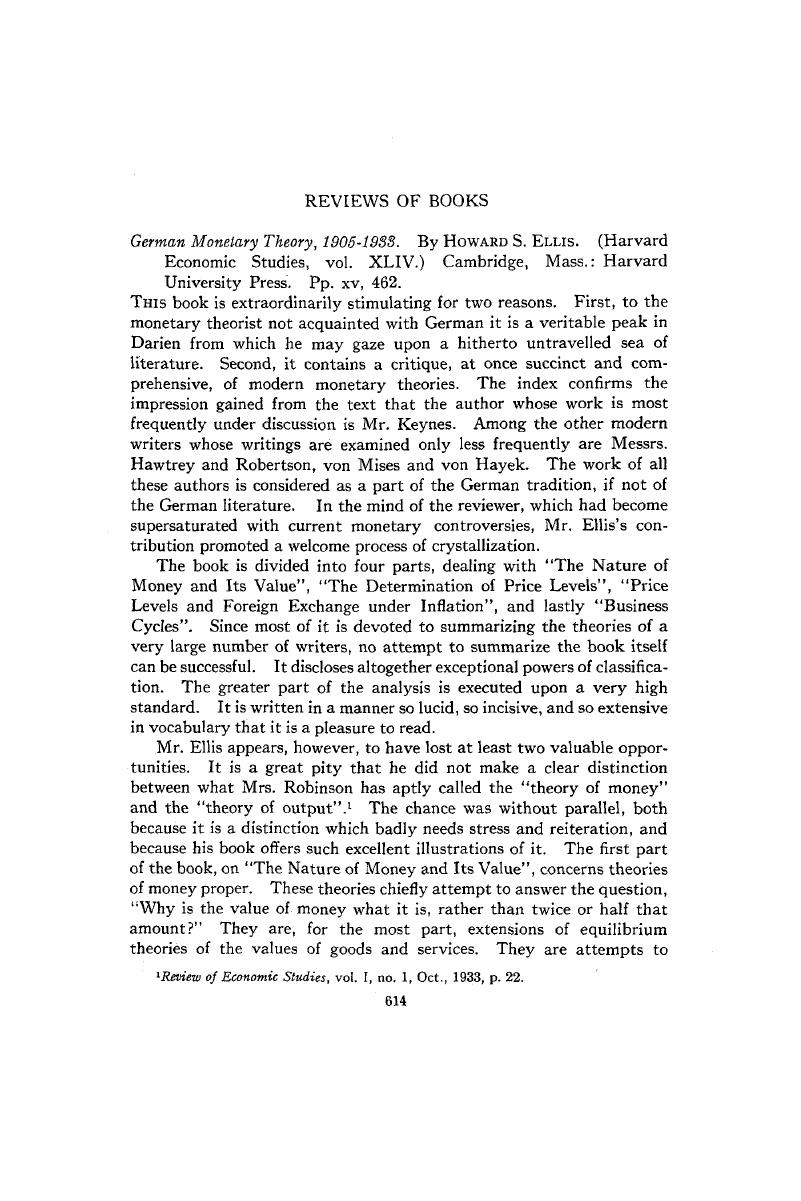No CrossRef data available.
Published online by Cambridge University Press: 07 November 2014

1 Review of Economic Studies, vol. I, no. 1, 10, 1933, p. 22.Google Scholar
2 Mr. Keynes and many others have compared the techniques of various money markets and considered the effects of these upon the efficacy of market control by central banks (see A Treatise on Money, New York, 1930, vol. II, ch. xxxiiGoogle Scholar). But no attempt is made to explain theories in the light of techniques. Mr. Ellis comes nearer to doing it when he explains the prevalence in Germany of some erroneous views about banking as partially due to the special methods of German banks (pp. 396-7).
3 Including the whole of the pre-War Austrian Empire with its chief cultural centre in Vienna.
4 See Willis, H. P. and Beckhart, B. H., Foreign Banking Systems (New York, 1929), ch. viii (by Quittner, Paul), p. 705.Google Scholar Alsoch. xv (by Hilding Melin), pp. 1032-4.
5 The strictures with which Mr. Ellis follows this sentence in his text seem to me to involve a misunderstanding of the position taken by Mr.Keynes, in the Treatise on Money, vol. II, p. 204.Google Scholar
6 Some of the generally unappreciated difficulties connected with the use of the conception are considered by Bladen, V. W. and Plumptre, A. F. W., “The Rate of Interest and Price Fluctuations” (Papers and Proceedings of the Sixth Annual Meeting of the Canadian Political Science Association, vol. VI, 1934, pp. 94–107).Google Scholar In that article extensive use was made of the “natural rate” technique; for the primary concern was there with interest rates. And I think that any alternative terminology would have made the argument considerably more cumbersome. Mr. Ellis would probably agree that the chief fault of the “natural rate” approach was the impression left upon the unwary that a monetary authority might justifiably confine its attention to interest rates and thereby determine its policy.
7 Bladen and Plumptre, “The Rate of Interest and Price Fluctuations”.
8 Ibid., p. 96.
9 Ibid., pp. 95-6.
10 Ibid., p. 95.
11 Some consideration of the importance of this “superior liquidity” in business cycle problems will be found in ibid., pp. 100-6.
12 Mr. Ellis is certainly not at his best in discussions involving a knowledge of the role of marginalism in theories of value. On p. 65 and elsewhere he adduces the fact that everybody uses money as a conclusive argument against the use of marginal theory in connection with money. “There are no excluded or extra-marginal buyers” and, therefore, he claims, marginal utility “loses its ordinary meaning”. As if there was no marginal purchase of bread just because we all eat it!
Again, on p. 87 in the saga of the Greenland fishing village which is overtaken by dyspepsia, he believes that the resulting “change of tastes unaccompanied by a similar change in the available goods certainly means that on the average a dollar at the margin of each individual's expenditure buys less utility”. It is doubtful whether the faith here displayed in the commensurability of metaphysical utilities, or in the efficacy of marginal theory to solve the insoluble, is the more simple.
13 The misleading of Mr. Ellis and others may be due to the fact that, in these equations, the real income of the community serves a dual purpose: first as one determinant, among a number, of the size of the real balances required; and, second, as a measure of the value of the money balances. To the problems of measurement we shall return in the next paragraph.
14 A Treatise on Money, vol. I, pp. 79–88 Google Scholar, and especially p. 86.
15 Ibid., p. 85.
16 Ibid., pp. 85-6.
17 Ibid., pp. 79-88.
18 When all the shots have hit the bull's eye the problem of dispersion disappears. It is perhaps for this reason that those who came upon the index number problem with the bias of the pure theory of money in their minds were disposed, as Mr. Keynes notes, to minimize the importance of weighting.
19 Ibid., p. 147.